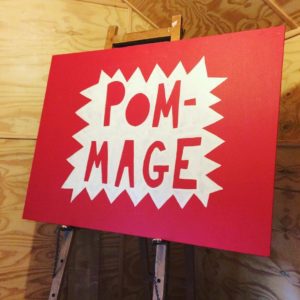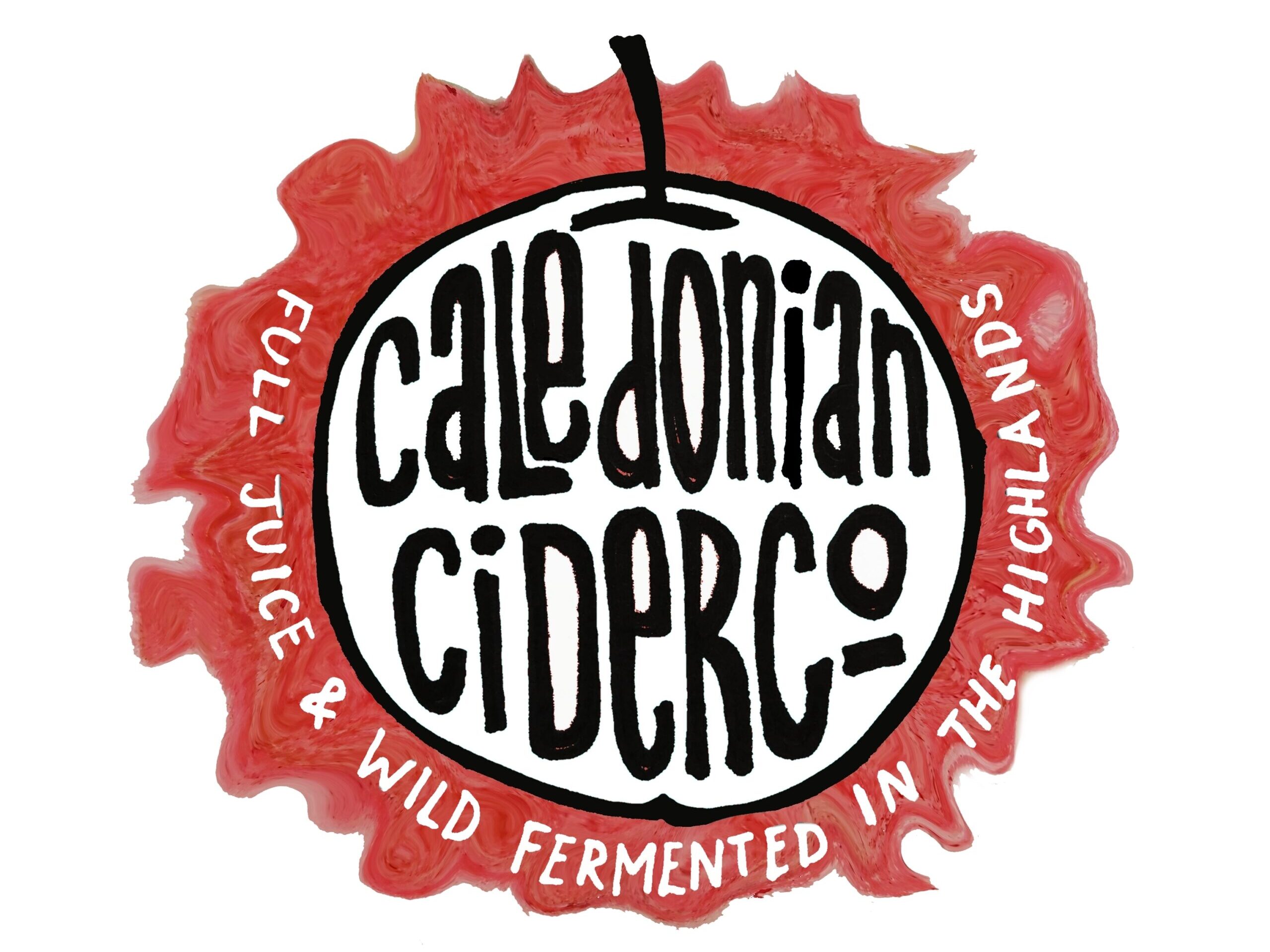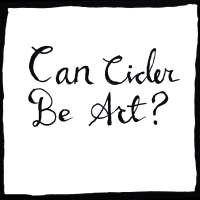Now, I’m not talking about labels here, although obviously some of them are totally brilliant, my current personal favourite being that of Pomage by Skyborry Cider which I’ve never actually tasted but want to on that basis alone. In this post I’m talking about the possibilities of the actual liquid of cider as a work of art.

Art is defined by the Oxford English Dictionary as the expression or application of human creative skill and imagination, typically in a visual form such as painting or sculpture, producing works to be appreciated primarily for their beauty or emotional power.
Using this definition (which I think seems to be a fair one) could we ever say that cider is art? I think there’s a good argument to make for it. All cider is a product of human creativity and imagination to some degree (obviously there’s a scale here) and much like any other art form we can experience cider using all our senses. While it can certainly be pleasant to hear the pop, hiss and splosh or see the effervescent and shimmering golden liquid play with light in unexpected and mesmerising ways, ciders real impact comes from its aroma*. Aroma can do extraordinary things to a person, when you smell something your brain is forced to wander back in time through myriad corridors and rooms searching for an association, a memory of a time when you first experienced it, first learned a name for it, the first whiff of freshly cut grass, bread from an oven or summer rain on hot tarmac and for just a moment we lose ourselves. An oft given example is found in Swanns Way by Marcel Proust where the narrator is catapulted into nostalgic reverie by the taste of a tea soaked cake. Taste and memory are, we can say with absolute certainty, heavily intertwined and therefor so is cider.
OK, so we’ve more or less established that cider is a (mostly) human creation and that it has the power to evoke an emotional response. So far so art then. But I think there’s one more crucial hurdle for cider to jump before it can gain entry to the Tate** For me a cider-as-art must be both appreciated and made, primarily for the sake of its beauty. This is the tricky bit. It really comes down to the philosophy of the cidermaker and the reason for the cider they make. “Why do artists make their art?” and “Can art be made for money?” are hardly new questions but they are interesting to think about in the context of cider. Cidermakers (like everyone else) need money to live so we can hardly discount any cider that is sell-ing as being a sell-out, there instead exists the exact same uneasy, endlessly debated and somehow mutual relationship between art and finance. So if it’s not the money that determines the authenticity of the artwork then what is it? Does it go back to the reason the cider was made? If it was made to fill a gap in a market or made to fit a certain price band then it doesn’t feel right to call it art does it? For me that would veer towards the mass re-produced pictures that sit on the shelves of our supermarkets (they may be nice to look at but they are basically just wall fillers). To be art, cider must be made purely for the joy of creating it, because it can be done not because it must be done. It’s a bit like artwork that’s used for advertising, there’s a big difference (to me) between if it was commissioned to be made as advertising or if it was created then co-opted into its advertising role if you know what I mean? And that’s how I see it with cider. A cider made to a margin or a style guided by market research may well be good but is it art and could it ever be great?
Cider made in this way is never going to be big business, it needs support to continue and even flourish, it needs patronage. Specialist retailers, craft focused bars and restaurants are all key outlets but on a more grassroots level so are the cider clubs. Cider clubs like that organised by Ross on Wye Cider & Perry in Peterstow are a lot like exhibitions where art lovers get to meet the artists and hear them explain their work. Other cider clubs have sprung up around the country in the last couple of years (Manchester being particularly noteworthy for its trailblazing enthusiasm and pioneer attitude) offering similar opportunities to experience, taste, learn and above all enjoy these rare and wonderful ciders often in the company of the makers themselves, this grass roots movement is spreading the word to areas of the country where cider has rarely been seen in its finest and purest forms, far flung galleries curating some of the finest examples of cider on the planet with little fanfare and great modesty. A new breed of cider drinker is emerging, the Beer and Cider Academy in London is now training Pommeliers (actual Cider Somelliers!) who are going forth into the wilderness armed with both knowledge and enthusiasm, a great example of what this means for cider can be seen just north of Durham at Fram Ferment, a bottle shop and tap room run by Susannah Mansfield who having freshly qualified as a Pommellier is now bringing the finest examples of what cider can be to a whole new group of people in a new area in a new way far from the traditional cider heartlands, a cider missionary if you like. Fram Ferment is hosting a quarterly cider club featuring both phenomenal ciders and their makers to explain them. Also, very recently Crafty Nectar have launched a fine cider subscription which will act as a sort of online cider club thus opening the door to a whole world of cider possibilities that would hitherto have been unimaginable for many.
Now, exhibitions (is that the right word for a cider club) often have price tags so let’s get back to money. These ciders will almost invariably cost you more than a bottle of mass produced stuff from the supermarket, sometimes considerably more. These higher prices aren’t funding a lavish cidermakers jet set lifestyle (at least, not to my knowledge), they aren’t going into shady off shore bank accounts or dodgy hedge funds, in fact that’s more likely where your £1.50 a bottle mainstream cider mass produced by a big international brewing conglomerate is going. The higher price is allowing an artist to continue to make their art and that must (for no other reason than the world would be a poorer place without it) be a price worth paying. Obviously most of us can’t afford to only drink the finest ciders known to man, there’s nothing wrong with your standard go to cider after all. These ciders are a treat, an occasion in themselves, Champagne wouldn’t be Champagne if we drank it everyday would it? They’re to be savoured and enjoyed, experienced and talked about, we don’t go to the gallery to see the latest KFC advert, we go to see something special.
Enjoy your cider,
Ryan (Lavish Jet Set Cidermaker)
*I say aroma rather than taste here because the vast majority of what we commonly call taste is actually aroma, taste being limited to the sensations of salt, bitter, sweet, sour and umami.
**The consistently beautiful cider of Find & Foster is actually available for sale at the Tate Modern in London right now,

